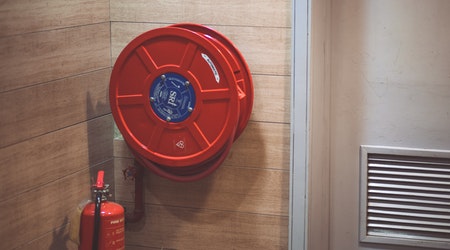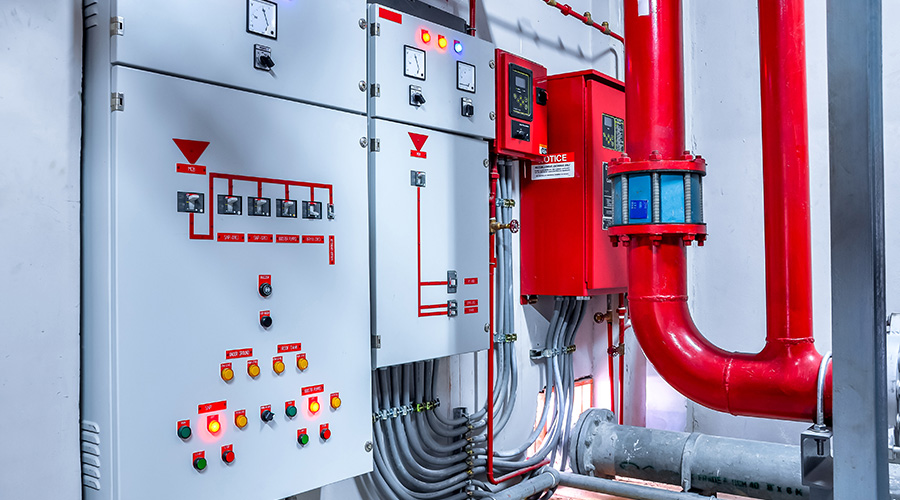Safer approaches to fire and life safety
Changes to standard practices in three areas might save lives in future emergencies. But old ways could prove hard to change
Pathway Marking Can Speed Evacuation
Signage and markings can play crucial role if a building loses power
It is essential for facility executives to realize how poor conditions can be during an emergency, and how important it is that every reasonable effort be made to ensure that occupants can move through passageways and stairs as rapidly as possible. Walking in darkness is not something that many people do with confidence. Even at home, movement is slower in the middle of the night; how can rapid movement through darkness be expected in an unfamiliar environment during an emergency? The answer, of course, is that it cannot.
During the evacuation of the World Trade Center as a result of the 1993 bombing, the loss of normal and emergency power left the stairways in total darkness, a darkness that far exceeded what will typically be encountered at night in a home. A survey by the National Fire Protection Association after the attack revealed that, for those who made the decision to exit, more than 60 percent needed more than an hour to get out.
As a result of those problems, the Port Authority of New York installed a photoluminescent pathway marking system to highlight the locations of treads, landings, handrails and exits. Photoluminescent safety markings glow in the dark after being charged by normal ambient lighting. They are non-electrical and non-radioactive, and the glow is very bright in the first 90 minutes but can be visible for several days.
Although it has been widely reported that the lights remained on during the attacks on Sept. 11, there have been some reports of lights having been off in parts of some stairways. At least one survivor of the South Tower relied on the pathway marking system to descend from the 84th Floor, using it to navigate past a darkened, smoke-filled section of the stair in the impact zone. Further investigation should reveal what role the photoluminescent pathway marking played in egress.
One thing is clear: Had circumstances been the same as in 1993, with no light in the stairways and no pathway marking, egress would have been significantly slower on Sept. 11, and many more people would have died.
Another case in point was the MGM Grand fire in Las Vegas in 1980, which resulted in 85 deaths. With overhead lighting and exit signs obscured by smoke, many occupants were left in the dark without direction. Egress was slowed or stopped altogether.
In 1989, California adopted a law requiring pathway marking and low-level exit signage in new assembly, educational, health care and hospitality facilities. In 1993, following a cruise ship fire that killed 158 people, the International Maritime Organization (IMO) passed a similar requirement.
Beating a Path to the Door
Pathway marking systems are not meant to be obtrusive or noticeable under normal conditions, but should power be lost during a fire, earthquake, terrorist attack or blackout, or should overhead lighting and exit signage be obscured by smoke, these systems should identify the egress path with a continuous stream of information. Numerous studies, most notably the 1999 study by Canada’s National Research Council, support this stream-of-information approach.
Exit signs are the last piece of information an occupant needs during egress. Without a continuous stream of information from their point of origin, occupants may never reach that exit sign.
ASTM Standard 2030-99, “Guide for Recommended Uses of Photoluminescent Safety Markings,” shows a system that provides a continuous stream of information for occupants, a stream that mimics the appearance of the systems required by California and the IMO. In Europe, where it is already a recognized part of the egress system design, pathway marking is required in many types of occupancies. In this country, the Federal Aviation Administration started requiring aisleway marking on airliners in the mid-1980s. The American Passenger Transit Association (APTA) passed a requirement for pathway marking on all new commuter trains as of 2001 and existing commuter trains by 2006.
These changes are welcome, but they leave a door open that is best closed; failure is still possible. Every requirement adopted to date has allowed the use of either photoluminescent or electrically powered systems. While electrically powered systems can be designed to be brighter than photoluminescent materials, they can never be as reliable, given their dependence on power. Several cruise lines came to this conclusion after fitting what they found to be high-maintenance electrical systems in passenger areas and low-maintenance photoluminescent systems in crew areas.
Interior designers on cruise ships tend to opt for electrically powered systems, which they find more attractive. In fact, designers sometimes want the pathway marking systems to be left powered at all times to serve as a design element in the space. That’s a mistake. Pathway marking systems should not to be treated as a decorative addition to the environment. Weekly testing of pathway marking systems is already required, and continuous use only serves to age the system prematurely and increase the incidence of failure.
What’s more, if occupants notice a pathway marking system under normal conditions, it may not stand out during an emergency. This does not mean that occupants should not be informed of the presence of a pathway marking system. Passengers on commercial flights and cruise ships are informed that the system is there to help them find an exit.
It’s also important to keep in mind that electrically powered pathway marking systems, known as low-location lighting on cruise ships, are not 100 percent reliable, even with the most rigorous maintenance routine. A 1998 cruise ship fire revealed this. The control panel for the low-location lighting system sounded a trouble alarm five minutes after the fire started. Because there was no switch to silence the alarm, the chief electrician shut down power to the entire system, which turned off all low-location lighting throughout the ship. Fortunately, no one died as a result of shutting off the low-location lighting, but two crewmen trapped in a restroom near the fire were unable to find their way out through the smoke because the passageway was “totally black.” The two were found by firefighting teams checking the area 30 minutes after the fire started.
What Lies Ahead
Photoluminescent products can be used in most every case to provide the continuous stream of information that occupants need to egress. There will be exceptions, such as where there is no ambient light to charge the photoluminescent material, but they will be few and far between. It seems likely that photoluminescent systems will be the rule in the future. One reason is code changes. For example, in New York City, code changes proposed as a result of the attacks on the World Trade Center would mandate photoluminescent pathway marking systems. Another factor that seems likely to drive adoption of photoluminescent pathway marking systems is tenant interest: A 1.4-million -square-foot building is putting in a photoluminescent system in response to tenant demand for that type of system. Finally, there are operational issues. The electrically powered pathway marking systems used in ships and airliners are less reliable and also more costly to maintain than photoluminescent systems.
Pathway marking is also capable of replacing overhead emergency lighting. It does not matter how bright emergency lighting was designed to be if it is not operating or cannot penetrate the smoke. The National Research Council of Canada has stated that photoluminescent pathway marking “appears to be a cost-effective addition or even a potential replacement for traditional electrical emergency lighting, since it does not consume energy, requires no wiring, needs minimum maintenance and is totally reliable, provided it is installed in locations where permanent full lighting is provided.”
Sept. 11 marked the onset of a new era in which previously unthinkable attacks are possible. Buildings should be designed accordingly. Photoluminescent pathway marking systems are an important element of an effective life safety system. Although it will take some years for the fire protection industry to require the use of photoluminescent pathway marking systems, these systems will improve the level of safety for occupants wherever they are used.
James D. Amy, Jr., is a consultant for Rolf Jensen & Associates, Inc., a subsidiary of The RJA Group. He has more than 10 years of experience in the development, design and management of fire protection and life safety programs.
ADA Evacuation Question: Who Needs Help?
Old principles must be modified to meet new risks; issue is broader than people with obvious physical disabilities
Since the attacks on Sept. 11, the old rules of emergency evacuation for people with disabilities now seem naive. The standard plan was based on determining the safest, most expedient and most effective methods of providing safe haven, rescue assistance and safe evacuation. Following Sept. 11, three fundamental points have to be considered in emergency evacuation planning:
- The threats no longer come just from fire.
- There is a new focus on the time it takes to evacuate many people from a high-rise commercial office structure.
- It is crucial to know who is in a building and to understand their ability to evacuate by means of stairs.
The rules have changed for facility executives dealing with individuals with disabilities, and so have ADA compliance strategies. Before Sept. 11, the conventional thinking was that asking someone if he or she had a disability could be interpreted as discrimination. Historically, that type of question was often a precursor to attempts by employers to screen out individuals with disabilities from employment opportunities. Before Sept. 11, companies were generally advised that this type of question could only be asked when it was absolutely essential.
To a considerable extent, that’s still true today. What’s different is that it has become crucial for facility executives to know who is in the building and what difficulties they may have if it becomes necessary to evacuate the building. That doesn’t mean asking whether a person has a disability; instead, it means asking who may need assistance.
The distinction matters. Rules for requesting information about someone’s disability are set for employers by the U.S. Equal Employment Opportunity Commission (EEOC). The federally funded Job Accommodation Network (JAN) also has specific items and suggestions.
The U.S. Access Board — the agency that writes the technical and scoping requirements of the ADA — also provides information and guidance.
Employers are allowed to ask for information that relates to the safety of the employee or others. The optimal approach is to ask all employees — not just those with disabilities — to inform the responsible department/person if and what assistance anyone would need in order to safely evacuate the building during an emergency. With that approach, there is no need to ask someone if he or she has a disability and, if so, to disclose that disability. Instead, the facility executive is asking for information that will make it possible to safely evacuate everyone. Inserts into company newsletters, or communications sent out by property management to tenants, should highlight the organization’s efforts to provide a safe and effective environment for all tenants and visitors.
Don’t assume that individuals with obvious physical disabilities are the only ones who will have difficulties evacuating. Individuals with a range of medical conditions (i.e., asthma, heart condition) or any employee who is recuperating from an injury or surgery may have difficulty using steps as a means of evacuation.
It will be particularly challenging to get individuals with hidden disabilities (panic disorders) safely out of the building. Anticipating and being prepared for that eventuality will be very important.These guidelines apply whether it is an owner-occupied building, an educational or governmental building, or a multiuse commercial building.
Assuring Safety
Once the facility executive has determined who needs assistance, there are important measures to help ensure that all tenants and visitors can be safely evacuated.
For one thing, don’t make practice evacuations voluntary. Those who will opt out of the exercise may in fact be the ones who will pose the greatest challenges — and most likely will not be ones with disabilities. Practice evacuations with less than the full complement of people in the building can also give a false timeframe for evacuating the building.
Another step is to refine or develop a safety team consisting of staff of the organization. These teams present an opportunity for the development of a “buddy program,” whereby team members are paired with individuals with disabilities to assist them in the evacuation and rescue process.
In developing an emergency evacuation plan for people with disabilities, it’s important to remember the basics. Work with local fire officials. Communicate with all employees; in multitenant buildings, communicate with tenants and encourage them to do the same with their employees. Show everyone where rescue paths are located. Do an assessment to determine what additional equipment may be needed and determine the best location for the equipment. Make sure your key safety team members know where the equipment is stored.
Nothing can replace a calm and safe evacuation. That cannot happen without planning, communication and practice.
Joan W. Stein is the president and CEO of Accessibility Development Associates Inc. (ADA Inc.), an ADA consulting firm located in Pittsburgh.
Taking a Hard Look at Emergency Plans
Informal polls across the country last fall revealed that some tenants never knew that their facility even had an emergency evacuation plan until after the events of Sept. 11. The World Trade Center, though, had one — a good one. “Their emergency response plan did pretty much work,” says Jon Evenson, safety consultant, Sako and Associates. That example has led many facility executives to take a hard look at their own emergency evacuation plans — and, in many cases, to improve them.
“Right now, there are some good things happening,” says Robert Solomon, assistant vice president for building and life safety codes, National Fire Protection Association (NFPA).
One thing companies should reevaluate is the mustering point, where employees gather after an evacuation. The area needs to be in a safe location, not the sidewalk in front of the building. “You want to try to put a structure between you and the threatened structure to stop flying debris and to avoid any fire, smoke and water hazards,” says Ross Bulla, president, The Treadstone Group.
Staging evacuation drills is critical. “You can have a great written program,” says Evenson, “but if it is not doable, it is not worth much.” He acknowledges that drilling takes time, which can cause problems, but emphasizes that drills are critical for an effective emergency response plan.
Bulla recommends another sort of drill in which building managers and engineers come in on a weekend and participate in an evacuation from the top floors with nothing but emergency power so that they can identify obstacles. He says that this has prompted many companies to paint handrails and stairs with luminescent markings; install more PA systems, particularly in stairwells, not just on floors; install first aid kits; and move the lighting lower on the walls.
Another step worth taking is to double check that employees are aware of all exits. Companies should also be sure they comply with NFPA code on selective stairwell reentry, so that occupants need not travel more than five floors before they can exit back into an occupied floor. If part of a stairwell is contaminated or blocked, people need to be able to exit that stairwell and find another one.
Even with the best of planning, extraordinary events can overwhelm emergency evacuation procedures. “A huge, horrible event can render traditional plans useless,” says Solomon. “People must still be prepared to throw out the play book, evaluate the situation and improvise.”
— Angela Maas managing editor
Survival Strategies for Fire Alarm Systems
Although not yet required by code, added measures provide margin of safety
Since Sept. 11, there has been new concern among building owners and occupants about the survivability of fire alarm systems — their ability to remain functional even under the most adverse conditions. The events of that day have increased fire safety awareness throughout the country and underlined the need for reliable fire alarm and communication systems in commercial buildings.
A number of factors contribute to the survivability of the fire alarm system. The most important is system architecture, which should be dispersed throughout the building. For example, in older systems, a single data-gathering panel and amplifier were usually placed in one location, so if an incident occurred adjacent to this location to disable the panel, the entire system would fail.
Today, the panels are distributed over many different areas, often on every third or fourth floor, and are able to operate alone. They will continue to function even if there is a failure at the head end or in the communication network. The audio system components are also designed with built-in redundancy and distributed throughout the building, so communication will carry on even if one or more of the amplifiers goes down.
Upgrades in head-end equipment — the fire alarm control panel and the fire command station — have also improved survivability. In older systems, the control panel was usually hidden out of sight, typically in a non-conditioned and unsupervised area, such as the basement, and had no associated audio system. Contemporary panels are not only equipped with voice communication capability but are also more effective when positioned on the ground floor.
The fire command station is also sited in a prominent position — the main building lobby. This is a modification applauded by fire departments and engineers, yet less appealing to architects. Local building codes determine the specific locations of both the control panels and fire command station required by the authority having jurisdiction.
Auxiliary Command Station
Within the past five years, it has also become common to institute an auxiliary fire command station at a second site in the building. This station is an exact replica of the first, with a full set of controls, but is separated from the primary station by at least a two-hour fire-rated construction element — that is, beyond one or more firewalls designed to keep systems from being exposed to fire and to provide additional response and evacuation time.
Each station is separately manned. The two do not operate simultaneously to avoid issuing conflicting instructions. All new safety systems include provisions for remote command stations, subject to the approval of local authorities. They do increase costs so the owner must decide whether to have these systems specified and installed. Nonetheless, recent events appear to have encouraged owners to include auxiliary stations as an additional level of protection to facilitate system survivability, occupant safety and evacuation.
Continuous communication is critical for fire safety, so upgraded communications risers go hand in hand with improved system architecture. Network communications are now designed with protocols that do not depend on a single pair of wires from panel to panel. Instead, the communications path is wired in a loop from the last panel on the riser back to the head end, enhancing network communication survivability. This circular path allows for unimpaired two-way communications even if part of the path is knocked out. Each system should include both a primary and a redundant fire-protected riser installed at a distance from each other and separated by at least one two-hour rated construction.
Backup Power
A suitable power supply is essential to the survivability of the fire alarm system. The fire safety system should be hardwired to a dedicated power source and circuit that are not utilized for any other equipment in the building. That eliminates the chance for other equipment or system malfunctions to jeopardize the primary power source, leaving the safety system inoperable.
There should be a secondary source for emergency power. This backup power source, an emergency life-safety generator, for example, is sometimes mandated by local code for such building types as high-rise commercial structures and health care facilities. International code requires the generator for new construction. Because the secondary power supply is cost-intensive, the owners of other types of buildings must make their choice on the basis of costs and benefits.
It might also be prudent to install a tertiary source, such as batteries placed in proximity to fire alarm panels. An additional option is an uninterruptible power supply system. These systems will maintain power for only a limited period of time, but they furnish a window for immediate emergency action. Although it will be costly to have four distinct power sources and that approach may not be seen as a necessity in most cases, each adds a level of survivability to the system and ensures a greater degree of safety.
Better Wiring
There are also several choices in the types of wiring used for the installation of field devices, such as smoke detectors, speaker strobe lights and sprinklers. Class A wiring is composed of a primary circuit with a return that will ensure the device’s operability even if there is a break in the wire. This method, however, is very expensive because it doubles the amount of fire alarm cable required and increases the associated labor cost. Class B wiring provides for just a single pair of wires to every device with no return circuit and does not ensure full system survivability. The modern systems are also fully supervised as required by codes and standards. As a result, the use of Class B field circuits, as approved by NFPA 72, are common in today’s installations.
Furthermore, rather than connecting all the devices to a single circuit, each floor should include multiple addressable initiating circuits and multiple notification circuits. Although a single circuit may have the rated capacity to handle all the devices on a given floor, it is preferable to distribute the devices so they are not all dependent on one circuit. Another device that many building owners are currently investing in is a firefighter telephone system to enable two-way communication from all locations in the building to the fire alarm control panel. This type of system was only previously used in high-rise applications.
The specific sequence of operations is also important to survivable systems. The fire alarm system should be linked with the other critical building systems — elevators, HVAC and fire pumps, for example — to control them in the event of an emergency. The alarm system should be laid out in such a way that it will interface with the control mechanisms of these systems and its activation will shut them down or start them up as required.
Finally, there is the human element, the most important factor of life safety. Thorough training of end-users is necessary to ensure that the systems will achieve their aims. Even the most sophisticated and survivable systems will not suffice if fire safety personnel and building occupants do not know how to respond correctly to an alarm. A thorough evacuation plan and fire safety training must be initiated in all buildings to take full advantage of the safety systems and features built into the building.
Owners Must Make Choices
Although many of these features have not yet made their way into building code requirements, they are all desirable to enhance protection against unforeseen events. The installation of new features is not restricted to new construction; they can all be added in retrofits. Because the newest systems have an impact on the available space, the owner must decide whether to give up the real estate required for redundant risers, distributed panels and backup power sources and must select the systems most appropriate to the property.
In new construction, the increase in equipment and materials required by the redundant elements will increase construction time, which will affect scheduling. It should also be understood that retrofitting an occupied building will cause disruptions to the active working area. In both cases, it is evident that upgrading fire-safety systems does lead to added costs that bring no obvious return on investment.
Building owners tend to seek the most cost-effective and code-compliant systems installation and may hesitate to upgrade unless local law or their insurance underwriter requires them to do so because of a specific hazard or threat. Yet it is no less evident, especially since Sept. 11, that increasing the safety of occupants has benefits of its own.
James Carrigan is a senior engineer for fire and life safety in the New York City office of Syska Hennessy Group, a national consulting, engineering, technology and construction firm.
He is also a chief officer and firefighter/paramedic with the East Rockaway (N.Y.) Fire Department, which was actively involved at Ground Zero on Sept. 11, 2001.
Related Topics:












